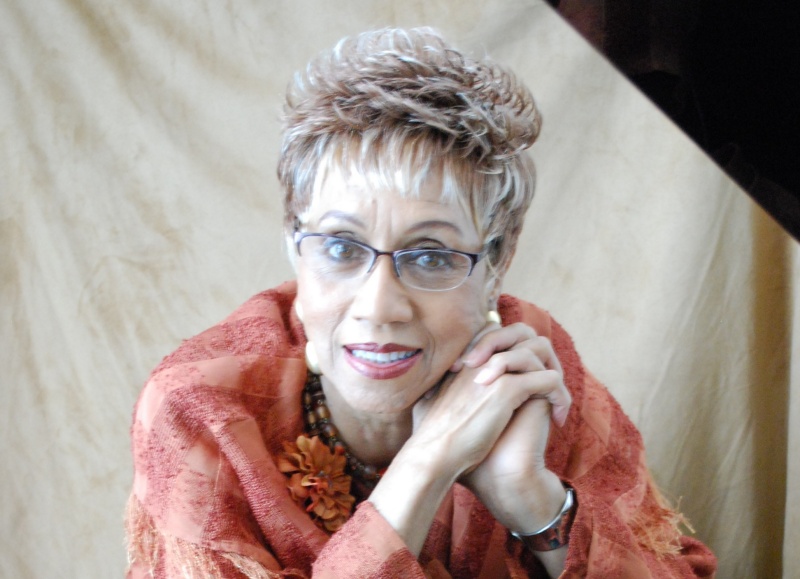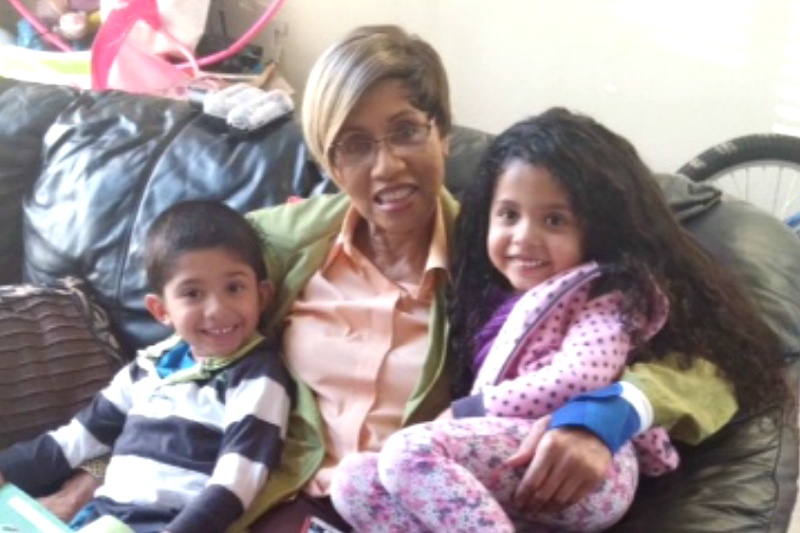
The Unseen Children's Music Side of an Award-Winning Career
An Interview with Jacqueline Hairston
by Hassaun Ali Jones-Bey, editor
Jacqueline (known as Jacqui) Hairston’s musical career as an award-winning ASCAP composer arranger, pianist, and music educator, in particular of Negro Spirituals and music of the African Diaspora, has received a great deal of acclaim. A graduate of Juilliard, Howard University, and Columbia University, who now lives in Sacramento, Jacqui’s numerous awards include the Los Angeles Living Legends Award for arranging African-Diaspora music and induction into the Alameda County Women's Hall of Fame for Culture and Art. Her works have been performed by internationally renowned solo artists such as Kathleen Battle, Grace Bumbry, Denyce Graves, and the late William Warfield, and also by orchestras worldwide. In 2012, she debuted at New York's Carnegie Hall as invited guest conductor with 300 singers (from around the country) performing her trademark choral arrangements of spirituals. In 2013, she served as resident-composer, commissioned by “The Negro Spirituals Project” in Denver, Colorado, to create and premiere music in tribute to the University of Denver's first African-American graduate (class of 1900), Madame E. Azalia Hackley. In addition to being too long to include here, the list of Jacqui’s awards, commissions, and accomplishments is ongoing. I happened to meet her in October 2014 while she was receiving the Howard Thurman Award in San Francisco for her life work with the Negro Spirituals. Having previously noticed an item on her website about an award for working with children, I decided to ask her about this seemingly hidden aspect of her career. I was surprised to learn that the current focus of her evolving musical endeavors—on the capacity of music to promote healing—was largely inspired by her work with children. The gist of our conversation follows.
PIO!: Please describe the childhood influences that interested you in music and led to your early musical development.
JH: I had teachers, from elementary school on, who encouraged singing. When I started at the age of eight—which was considered late in my neighborhood—to learn to play the piano, all I wanted to do was “play catch-up” and then pass the others.
PIO!: How has your career carried you into making music with children?
JH: I was always fascinated with children’s vivid imaginations. I fancied being with them to “play along,” while also envisioning my own inner child’s play engaging and being engaged.
 Jacqui Hairston with her great-grandchildren.
Jacqui Hairston with her great-grandchildren.
PIO!: Please describe the types of children’s music programs that you are or have been involved in.
JH: Umpteen years ago, my first job—which lasted for several years—was in my hometown of Charlotte, North Carolina, as a music consultant for elementary school children and their teachers. I worked on several grade levels leading up to becoming an assistant professor at Johnson C. Smith University, the primary Black college in Charlotte. Upon moving to California from North Carolina (in the mid ’70s), I developed a music learning program for children at an elementary school in Alameda, with encouragement from the principal. Always one to involve other associates in the music-making process, I engaged two other music colleagues: Helen Dilworth for singing and Ben Jones for instrument (trumpet). We created songs and used songs from the African-American experience that were especially appropriate for children’s sing-alongs and that were also easily taught. We continued that for a couple of years. The principal, unfortunately deceased now, had us come in periodically and present learning music shows for the children, who ranged from kindergarten through second grade. We couldn’t go into the history as deeply with them as we could with older students. It was more like play time with rhythm instruments, dancing, and singing. Ben would tell them what his instrument was and give them an idea of some of the different sounds he could produce. Helen and I would teach them rather simple spirituals and have them sing, call-and-response style. We’d also ask them, if the songs were really lively, if they wanted to get up and dance; they all would get up and dance, or simply create their own made-up movements.
PIO!: Could you say a bit about the range of your work with children?
JH: Wow! That really runs the gamut. As mentioned earlier, I was asked to be a music consultant for the elementary schools in Charlotte, North Carolina, immediately after graduating from Howard University, which gave me a “total boost” because of the children’s natural spontaneity and eagerness to respond to music. For six years, I worked with several teachers in the schools to teach songs and musical activities that enhanced learning. Next, I was assigned to junior high school for six years, and then to senior high, before being invited to teach on college level at Johnson C. Smith University. Feeling the urge to “get away” and teach in other than my hometown, I moved to California, where the rest is history. I took early retirement from Oakland’s Merritt College in 1988 to pursue other musical endeavors: composing and arranging music for prominent and internationally renowned singers and orchestras, which is still ongoing. Now I’m feeling the urge to reach back to the children’s level again and touch children who have learning disabilities or special needs. Back in North Carolina and later in Oakland, the sponsoring agents provided funding for doing this work. After I got into the professional arena, commissions began to come from orchestras, singers, and special patrons. So different funders made it possible for me to work in this transformative arena.
PIO!: I noticed a video clip on your website concerning a “Jefferson Award” that you received for working with youngsters. Could you say a little bit about that?
JH: That was a by-product of a team-teaching situation in Orinda several years ago. The parents of the school’s eighth graders felt that the children were not getting any history or social science about slavery or the spirituals. So they hired popular African Diaspora folklorist Linda Tillery and myself to come to the school and enhance what they and the teachers had already researched concerning the positive contributions that had come out of slavery times. One of those positive contributions was the spiritual. They hired us to come for two different days to cover all of the eighth grade classes, or however many they could get into their gym at one time. We taught them the songs, and let them sing and dance to the songs and ask questions. We were shocked at how well those teachers had prepared them, because we started asking them questions like: Who was Harriet Tubman? And what was the Underground Railroad all about? And they all knew the answers. We were amazed. The parents actually hired us three years consecutively to do that. I would guess that was in 2007, 2008, and 2009.
PIO!: How has your musical involvement with children changed over the years?
JH: My work with children began to grow in particular around my four grandchildren from their earliest ages throughout their elementary school years. Now, I find myself having to recapture my ability to captivate children, including my great-grandchildren. They seem to, somehow, teach me about their musical desires, from playing my piano to singing their favorite and quite repetitious songs, learned in school or that they make up. My last engrossing experience while living in Oakland came when I was asked to work with children at the Burckhalter School, where the children were either blind or had hearing deficiencies. This was, by far, the most challenging of all my previous work with children.
PIO!: Could you say a bit about the challenge?
JH: The incredible challenge came while trying to figure out how to reach children with these disabilities. Through the encouragement of the teachers I came to realize that while those who were blind could at least hear, those who couldn’t hear could see and also feel the vibrations of the music. Incredibly, all could engage in the fashion most comfortable for them. To this day, I am still astounded, as I think back, at their adapting in the way or manner that best befitted them, while I was the only one worried as to “how to get over.”
The teachers used sign language to talk to the kids who could see but couldn’t hear. The teacher would introduce me and say I was there to teach them songs and to teach them about the history of these songs. I believe they were third graders. The ones who couldn’t hear amazed me. I said to the teacher, “I don’t know how I’m going to get across to them,” and he said, “They can feel the music.”
Some of them would stretch out on the floor. And because it was an upright piano, some would put their ears against the piano and they would just smile and move their little hands in time with the rhythm. So it was amazing. One time I saw how excited they got, especially the ones who could hear but were blind. I took my karaoke machine there with a microphone and they were so excited to participate. They all raised their hands to be the speaker for the day and introduce the songs. That was really exciting for me to see. I think it may have been more inspirational for me than it may have been for them. And that’s what influenced me to begin studying the sensations that music does create. I found myself drawn to study the healing effects of music. Now even at my present older age, I’m considering a study of music therapy, and find myself seriously debating how to engage in whatever course work might be necessary to move in that direction. How does music indeed heal situations with people, no matter the age, psychologically, emotionally, mentally, and spiritually? 
More information on Jacqui can be found online at her website: http://jbhproductions.com.